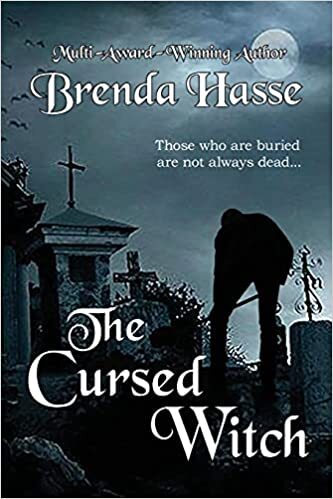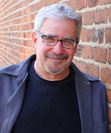This week’s guest: Brenda Hasse

This week I’m delighted to host Brenda Hasse, a multi-award-winning author and freelance writer. Brenda has written and published award-winning young adult historical romance, pre-teen historical mystery, and adult metaphysical/visionary novels. She is also the author of several picture books for children. Brenda volunteers her time researching and writing scripts for the Fenton Village Players to perform during the Ghost Walk and Historical Cemetery Walk. She resides in Fenton, Michigan, with her husband and cats.
I spoke with Brenda about her new release, The Cursed Witch.

DL: Congratulations on your new book! We’re anxious to hear what it’s about.
BH: The Cursed Witch is a romantic suspense novel based on Anna Stewart. Here’s the synopsis:
Edinburgh, Scotland, 1828—Born the seventh daughter of the seventh daughter, Anna Stewart is cursed as a witch. Shunned by society, she is blamed for her family’s misfortunes. The night before Samhain, Anna, now eighteen years old, is sent on an errand. Hearing shuffling footsteps behind her, she turns, and her vision fades to black. She awakens to see the full moon in the cloudless night sky, grasps the freshly turned soil where she lay and watches as a fleeing pair of body snatchers disappear into the shadows of the kirkyard. Alone among the gravestones, she stares at the open end of a casket deep within her disturbed grave. As she begins to walk home, Anna encounters the town witch, who tells her she was murdered and buried. With the killer still at large, the old woman warns Anna to hide, or risk being killed, again.
Douglas MacEwan, the successful owner of a mercantile shipping company, is staying in the city while his ships unload and take on cargo before returning to Virginia. His happenstance encounter with Anna leaves him spellbound by her beauty. After learning of her plight, he offers to investigate and track down her murderer. Knowing he must soon depart with his ships, his affection for Anna grows, as does his determination to ensure she remains safe.
In a race against time, will Anna be able to unravel the mystery and identify her assailant or will her killer discover her whereabouts and attempt once again to silence her forever?
Please note—Even though The Cursed Witch is a work of fiction, it is based on history. Anna Stewart was declared dead at 18 years old, buried, and within 24 hours exhumed by two men, Martin and John. Many of the terms such as ‘graveyard shift,’ ‘dead ringer,’ and ‘saved by the bell’ (yes, the dead were buried with bells and often in mortsafes) that we use today, came from this time period when the poor living on the streets of Edinburgh, Scotland turned to ‘body snatching’ for money. In 1829, William Burke and William Hare were found guilty of killing 16 people for profit. Their wives turned them in, or so the rumors indicate. Hare was found innocent, while Burke was hung and his body donated to the autonomy theater. Dr. Knox was also tried for his role with the two men. He was found innocent and lived the remainder of his life in London, England.
Even though Anna’s birth order is not mentioned in history, it is true when a woman was born the seventh daughter of the seventh daughter, she was thought to be cursed and only someone outside of the family would volunteer to be a godparent.
I find it fascinating when true history is included in a novel. It makes it more believable. What truly happened to the real Anna Stewart? Once she ‘returned from the grave,’ she eventually married and settled in America. For further reading about the topic, Robert Louis Stevenson wrote a novel with the same setting in 1831 titled, The Body-Snatcher.
DL: What inspired the creation of the book?
BH: A friend from Edinburgh, Scotland, posted a brief summary of how Anna Stewart was exhumed from the grave. I found it fascinating and thought it would make an interesting opening chapter for a novel. Another friend encouraged me to write about a witch, and through research learned of the birth order curse. I could not find any other information about Anna or her family, but creating the fictitious birth order and cursing her as a witch added an interesting facet to the storyline.
DL: Could you talk about your writing process? Did it differ from the way you’ve written your other works?
BH: My writing process is flexible, such as life. I try to write everyday. Some days I write a lot, while others I write very little. I set a goal to write for a length of time or obtain a certain work count each day. My writing process is probably similar to many other authors—rough draft, rewrite, edit, edit again, format, send to editor, send to second editor, and publish.
I write most of my novels during National Novel Writing Month (November), but not this novel. I wrote The Cursed Witch during Spring 2021.
DL: What was the best part of/most fun about writing this book?
BH: Researching! I love history. I was able to travel to Edinburgh, Scotland, in 2016 and 2019, knowing that someday I would base the setting of a novel in the historic city. Writing about Anna, whose home was in Edinburgh, made her come to life, so to speak. I enjoy instilling each character’s personality, goals, and flaws to make them believable. I always try to include a cat or dog or both in each novel I write. Who doesn’t like a cat or dog?
DL: What was the most challenging part of writing this book?
BH: That’s an easy question—editing. I have discovered that I am more of an audio person than a reading person. When I read what I have written, I don’t always see my mistakes. I read what I think it should say instead of reading what it actually says. So, I am able to catch the mistakes easier when I listened to it read to me. I use the read back feature in my document. I also have two editors who help me find what I miss. However, even then some of the typos squeak through.
DL: How can readers purchase it or get a signed copy?
BH: The Cursed Witch may be ordered through any independent bookstore, Bookshop.org, and as always, Amazon or Barnes and Noble. Indie bookstores may order it through Ingram.
DL: Any final reflections about the book, or things you want people to know about it?
BH: Through my research, I learned the difference between a ‘graveyard’ and a ‘cemetery.’ A cemetery does not have a church on the grounds while a graveyard does. While in Scotland, I learned a church is called a ‘kirk’ and its graveyard is known as a ‘kirkyard.’ Also, an alley is known as a ‘close.’ Some closes join one street to another while others are a dead end into a residential area.
It’s always a little strange when I complete a novel. Even though the characters are usually make-believe, I experience a void when I am no longer interacting with their personalities.
DL: Thank you for joining us this week, Brenda. Much luck with the book!



